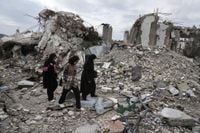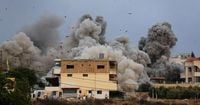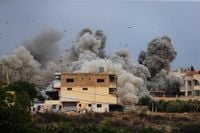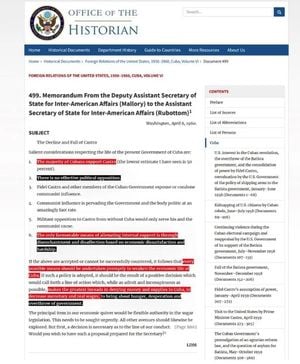Israeli jets unleashed a fresh wave of airstrikes on several towns in southern Lebanon on November 6, 2025, marking a sharp escalation in a cycle of near-daily attacks that has gripped the region for almost a year. The strikes came just hours after the militant group Hezbollah publicly urged the Lebanese government to reject any negotiations with Israel, deepening the rift and raising fears of renewed conflict across the border.
According to the Associated Press, the Israeli military issued explicit warnings to residents in several southern Lebanese towns—including Tayba near the border, Teir Debba just east of the coastal city of Tyre, and Aita al-Jabal—urging them to flee at least 500 meters (about 1,600 feet) from residential buildings marked for targeting. Later, similar warnings were extended to the towns of Zawtar al-Sharqiyah and Kfar Dounin. Israeli Arabic spokesperson Avichay Adraee stated that these buildings, nestled within civilian-populated areas, had been used by Hezbollah for military purposes.
The Israeli military claimed it was targeting Hezbollah’s military infrastructure, including weapons storage facilities, in these areas. "We will not allow Hezbollah to rearm themselves, to recover, build back up its strength to threaten the state of Israel," Israeli government spokesperson Shosh Bedrosian declared in a Thursday briefing, as reported by the Associated Press. The military accused Hezbollah of rebuilding its capabilities nearly a year after a U.S.-brokered ceasefire took effect in November 2024, ending a monthslong war between the two sides.
While most residents reportedly evacuated the threatened zones ahead of the strikes, Lebanon’s health ministry confirmed that one person was wounded. The ministry’s figures underscore the broader toll: since the ceasefire, more than 270 people have been killed and around 850 wounded by Israeli military actions in Lebanon. The United Nations human rights office, as of October 9, 2025, had verified that at least 107 of those killed were civilians or noncombatants, according to spokesperson Thameen Al-Kheetan.
These latest strikes coincided with a high-level meeting in Beirut, where Lebanese Prime Minister Nawaf Salam and his cabinet convened to review a plan drafted by the Lebanese military to disarm Hezbollah and other non-state armed groups. Information Minister Paul Morcos told reporters that the cabinet "commended the progress (the army) has made… despite continued obstacles, foremost among which is the continuation of Israeli hostilities."
Lebanese President Joseph Aoun, who has consistently criticized Israel’s ongoing strikes and its occupation of five strategic hilltop points on Lebanese territory, again voiced his disapproval. Yet, in a notable shift, Aoun also expressed willingness to negotiate with Israel in hopes of de-escalating tensions. In a statement following Thursday’s strikes, he remarked, "Every time Lebanon expresses its openness to peaceful negotiations… Israel intensifies its aggression." He continued, "Nearly a year has passed since the ceasefire came into effect, and during that time, Israel has spared no effort to demonstrate its rejection of any negotiated settlement between the two countries. Your message has been received."
The roots of the current hostilities stretch back to the aftermath of the October 7, 2023, Hamas-led attack on Israel, which triggered the war in Gaza. In solidarity with Hamas and the Palestinians, Hezbollah began firing rockets into northern Israel, prompting Israeli airstrikes and artillery shelling in return. What started as low-level exchanges escalated into a full-scale war in September 2024, culminating in the U.S.-brokered ceasefire two months later.
Since that ceasefire, both Israel and Hezbollah have accused each other of repeated violations. Israel maintains that its ongoing strikes are aimed squarely at Hezbollah officials and military infrastructure, asserting that the group has been attempting to rebuild its arsenal and capabilities. The Lebanese government, which has supported efforts to disarm Hezbollah, counters that Israeli strikes have frequently hit civilian areas and infrastructure unrelated to the Iran-backed group.
Hezbollah, for its part, has not stood down. Despite suffering severe losses during Israel’s intense air campaign in 2024, the group has yet to disarm. Its leader, Sheikh Naim Kassem, has insisted that Hezbollah remains ready to fight, regardless of how limited its capabilities might be. The group has claimed only one attack since the ceasefire took effect, and notably, no Israelis have been killed by fire from Lebanon during this period.
The situation is further complicated by international involvement. On the same day as the airstrikes, the U.S. Treasury announced new sanctions targeting what it described as "financial operatives who oversee the movement of funds from Iran" to Hezbollah. These sanctions focus on both licensed and unlicensed money exchange shops that, according to the Treasury, "fail to conduct adequate screening on their customers"—thereby enabling Hezbollah to exploit Lebanon’s largely cash-based economy for money laundering. The move underscores Washington’s ongoing efforts to cut off financial lifelines to Hezbollah, which Western governments have designated a terrorist organization.
Inside Lebanon, the debate over how to handle Hezbollah remains deeply divisive. The government’s plan to disarm the group and other non-state armed factions faces significant political and practical challenges. Hezbollah’s supporters argue that the group is a vital shield against Israeli aggression, while critics contend that its military activities drag Lebanon into unwanted conflicts and undermine national sovereignty.
For ordinary Lebanese, the nearly year-long cycle of violence has been devastating. The toll in lives lost, injuries sustained, and infrastructure damaged has only compounded the hardships of a country already grappling with economic crisis and political paralysis. Many residents of the targeted southern towns have been forced to abandon their homes, uncertain if or when it will be safe to return.
Meanwhile, the Israeli government remains adamant that it will not tolerate Hezbollah’s resurgence. Officials insist that the strikes are both defensive and preemptive, aimed at preventing the group from regaining the capacity to threaten Israeli territory. Yet, with each new round of violence, the prospects for a durable peace seem to recede further into the distance.
As both sides dig in—one with airstrikes and warnings, the other with defiant rhetoric and sporadic rocket fire—the border region remains on edge, a flashpoint where the smallest spark could ignite a much larger conflagration. The international community, for its part, continues to call for restraint and dialogue, but so far, the cycle of provocation and retaliation shows little sign of abating.
The events of November 6 serve as a stark reminder that, despite the ceasefire, the wounds of last year’s war remain raw and the path to lasting peace is fraught with obstacles. For now, southern Lebanon and northern Israel remain trapped in a tense and dangerous limbo, where the threat of renewed conflict is never far from the surface.






